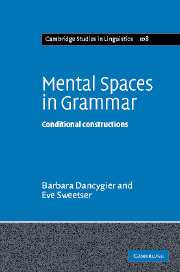Book contents
- Frontmatter
- Contents
- Acknowledgments
- Preface
- Note on abbreviated citations
- The door-scraper in the Wild Wood: an informal lesson in frame metonymy
- 1 Conditional constructions, mental spaces, and semantic compositionality
- 2 Prediction, alternativity, and epistemic stance
- 3 Tense, epistemic distance, and embedded spaces
- 4 Future and present forms in conditional constructions
- 5 Non-alternatives and alternatives: mental spaces in different domains
- 6 Then and even if: mental-space deixis and referential uniqueness
- 7 Clause order and space building: if, because, unless, and except if
- 8 Uniqueness and negative stance: only if and if only
- 9 Coordinate constructions and conditional meaning
- 10 The door-scraper in the Wild Wood: conditional constructions and frame-based space building
- References
- Author index
- Subject index
The door-scraper in the Wild Wood: an informal lesson in frame metonymy
Published online by Cambridge University Press: 22 September 2009
- Frontmatter
- Contents
- Acknowledgments
- Preface
- Note on abbreviated citations
- The door-scraper in the Wild Wood: an informal lesson in frame metonymy
- 1 Conditional constructions, mental spaces, and semantic compositionality
- 2 Prediction, alternativity, and epistemic stance
- 3 Tense, epistemic distance, and embedded spaces
- 4 Future and present forms in conditional constructions
- 5 Non-alternatives and alternatives: mental spaces in different domains
- 6 Then and even if: mental-space deixis and referential uniqueness
- 7 Clause order and space building: if, because, unless, and except if
- 8 Uniqueness and negative stance: only if and if only
- 9 Coordinate constructions and conditional meaning
- 10 The door-scraper in the Wild Wood: conditional constructions and frame-based space building
- References
- Author index
- Subject index
Summary
(From Chapter 3, The Wind in the Willows, 1908, by Kenneth Grahame)
[The Rat and the Mole are lost in the Wild Wood on a snowy night. As they are slogging through the snow, the Mole cuts his leg. The Rat, intrigued, tries to find the object that hurt the Mole]
Suddenly, the Rat cried “Hooray!” and then “Hooray-oo-ray-oo-ray-oo-ray!” and fell to executing a feeble jig in the snow.
“What have you found, Ratty?” asked the Mole, still nursing his leg.
“Come and see!” said the delighted Rat, as he jigged on.
The Mole hobbled up to the spot and had a good look.
“Well,” he said at last, slowly, “I see it right enough. Seen the same sort of thing before, lots of times. Familiar object, I call it. A door-scraper! Well, what of it? Why dance jigs round a door-scraper?”
“But don't you see what it means, you – you dull-witted animal?” cried the Rat impatiently.
“Of course I see what it means,” replied the Mole. “It simply means that some very careless and forgetful person has left his door-scraper lying about in the middle of the Wild Wood, just where it's sure to trip everybody up. Very thoughtless of him, I call it. When I get home I shall go and complain about it to – to somebody or other, see if I don't!”
“O dear! O dear!” cried the Rat, in despair at his obtuseness.
- Type
- Chapter
- Information
- Mental Spaces in GrammarConditional Constructions, pp. 1 - 3Publisher: Cambridge University PressPrint publication year: 2005



